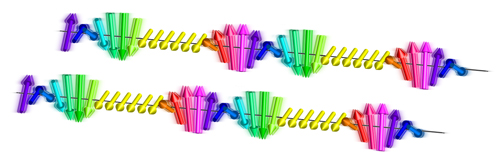Research News
Jun 21, 2022
Magnetic Superstructures Resonate with Global 6G Developers
Osaka Metropolitan University researchers observed unprecedented collective resonance motion in chiral helimagnets that allow a boost in current frequency bands.
Using a broadband microwave spectroscopy, the scientists detected unprecedented collective resonance modes at remarkably high and broad frequency bands. They found that resonance could occur in CSL at beyond-5G frequencies with a small change in the strength of the magnetic field.

Osaka, Japan – When will 6G be a reality? The race to realize sixth generation (6G) wireless communication systems requires the development of suitable magnetic materials. Scientists from Osaka Metropolitan University and their colleagues detected an unprecedented collective resonance at high frequencies in a magnetic superstructure called a chiral spin soliton lattice (CSL), revealing CSL-hosting chiral helimagnets as a promising material for 6G technology. The study was published in Physical Review Letters.
Future communication technologies require expanding the frequency band from the current few Gigahertz (GHz) to over 100 GHz. Such high frequencies are not yet possible given that existing magnetic materials used in communication equipment can only resonate and absorb microwaves up to approximately 70 GHz with a practical-strength magnetic field. Addressing this gap in knowledge and technology, the research team led by Professor Yoshihiko Togawa from Osaka Metropolitan University delved into the helicoidal spin superstructure CSL. “CSL has a tunable structure in periodicity, meaning it can be continuously modulated by changing the external magnetic field strength,” explained Professor Togawa. “The CSL phonon mode, or collective resonance mode ― when the CSL’s kinks oscillate collectively around their equilibrium position ― allows frequency ranges broader than those for conventional ferromagnetic materials.” This CSL phonon mode has been understood theoretically, but never observed in experiments.
Seeking the CSL phonon mode, the team experimented on CrNb3S6, a typical chiral magnetic crystal that hosts CSL. They first generated CSL in CrNb3S6 and then observed its resonance behavior under changing external magnetic field strengths. A specially designed microwave circuit was used to detect the magnetic resonance signals.
The researchers observed resonance in three modes, namely the “Kittel mode,” the “asymmetric mode,” and the “multiple resonance mode.” In the Kittel mode, similar to what is observed in conventional ferromagnetic materials, the resonance frequency increases only if the magnetic field strength increases, meaning that creating the high frequencies needed for 6G would require an impractically strong magnetic field. The CSL phonon was not found in the asymmetric mode, either.
In the multiple resonance mode, the CSL phonon was detected; in contrast to what is observed with magnetic materials currently in use, the frequency spontaneously increases when the magnetic field strength decreases. This is an unprecedented phenomenon that will possibly enable a boost to over 100 GHz with a relatively weak magnetic field – this boost is a much-needed mechanism for achieving 6G operability.
“We succeeded in observing this resonance motion for the first time,” noted first author Dr. Yusuke Shimamoto. “Due to its excellent structural controllability, the resonance frequency can be controlled over a wide band up to the sub-terahertz band. This wideband and variable frequency characteristic exceeds 5G and is expected to be utilized in research and development of next-generation communication technologies.”
Funding
This work was financially supported by the Japan Society for the Promotion of Science (JSPS) through Grants-in-Aid for Scientific Research (B) (No. JP17H02767) and on Innovative Areas “Quantum Liquid Crystals” (No. JP19H05826). This work was also supported by a Research Grant of the Specially Promoted Research Program from Toyota RIKEN, the Act of the Government of the Russian Federation (Contract No. 02.A03.21.0006), the Russian Foundation for Basic Research (RFBR), Grant No. 20-52-50005, and the Ministry of Science and Higher Education of the Russian Federation, project No. FEUZ-2020-0054. Y. S. was supported by Research Fellowships of JSPS for Young Scientists (No. 21J14431) and the Graduate Course for System-inspired Leaders in Material Science of JSPS.
Paper Information
Title: Observation of Collective Resonance Modes in a Chiral Spin Soliton Lattice with Tunable Magnon Dispersion
Journal: Physical Review Letters
DOI: 10.1103/PhysRevLett.128.247203
Publication date: June 17, 2022
Physical Review Letters (American Physical Society Webpage)
Contribution to SDGs

7: Affordable and clean energy
11: Sustainable cities and communities
Contact
Graduate School of Engineering
Prof. Yoshihiko Togawa
E-mail ytogawa [at]omu.ac.jp
*Please change [at] to @.
SDGs

